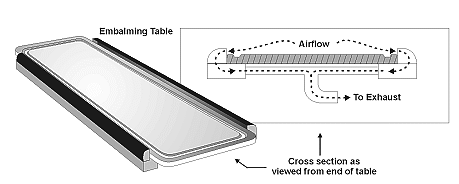Controlling Formaldehyde Exposures During Embalming
1998
DHHS (NIOSH) Publication Number 98-149
Hazard
Embalmers are exposed to formaldehyde at concentrations averaging up to 9 parts per million (ppm) during embalming. Short-term exposures to this strong-smelling gas cause eye, nose, and throat irritation at levels up to 5 ppm. At levels from 10 to 20 ppm, it causes cough, chest tightness, and unusual heart beat; and from 50 to 100 ppm, fluid on the lungs, followed by death. Exposure to formaldehyde over a long time may also cause cancer.
Controls
NIOSH engineers designed and evaluated a local exhaust ventilation [LEV] system that effectively reduces embalmer’s exposure to formaldehyde below the OSHA permissible limit of 0.75 ppm, as an 8-hr time-weighted average exposure.
Local Exhaust Ventilation
The LEV system consists of a pair of 6-ft-long slot hoods placed on each side of the embalming table. These slot hoods capture formaldehyde by means of an exhaust fan placed outside the embalming room. The exhaust fan maintains an optimum airflow of 700 cubic feet per minute. For a slot width of 1 inch, the slot velocity is 720 feet per minute. Embalming equipment manufacturers and distributors can provide LEV systems for existing tables, or a sheet metal contractor can custom build the LEV system [see Figure 1.].
General room (dilution) ventilation is another way to exhaust formaldehyde from the embalming room. Depending on how well the air in a room is mixed, 4 to 13 times more exhaust air is needed to achieve the same control as from the LEV system. Make-up air costs for heating or cooling are considerably less for the LEV system than for dilution ventilation. Therefore, NIOSH recommends that the primary control be the LEV system.

Figure 1. Diagram of local exhaust ventilation slot hood.
Acknowledgments
The principal contributors to this publication are Michael G. Gressel, Anne Votaw, Rosmarie T. Hagedorn, and Jerome P. Flesch. Drawing by Dick Carlson.
This document is in the public domain and may be freely copied or reprinted. NIOSH encourages all readers of this HAZARD CONTROLS to make it available to all interested employers and workers.
Controlling Formaldehyde Exposures During Embalming pdf icon[PDF – 157 KB]
